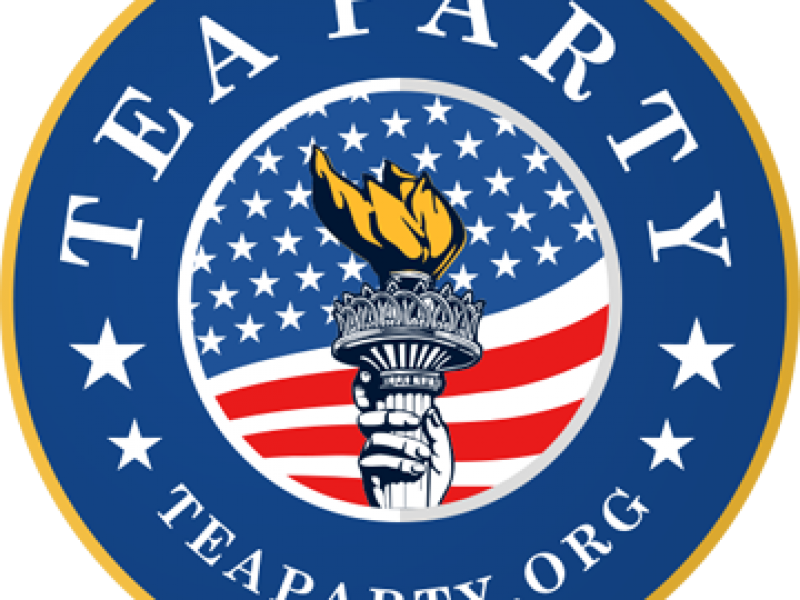"February 27, 2015 marks the 6th anniversary of the first nationally organized Tea Party protests. That first day of protests, sparked by Rick Santelli's call for a “Chicago tea party" on a February 19, 2009 episode of CNBC's Squawk Box, led to the formation of a loosely organized network of grassroots groups, known collectively as the Tea Party Movement (TPM). The TPM, according to the Declaration of Tea Party Independence, which was signed and endorsed by “at least 60" independent Tea Party groups in “more than 20 states", stands for smaller government, stalwart devotion to capitalism, and reverence for the U.S. Constitution. Unlike the majority of well-known American protest movements, the TPM falls far to the right on the political spectrum. Perhaps surprisingly, the TPM shares a great deal in common with a recent movement that originated from the left, Occupy Wall Street. Occupy Wall Street (OWS) protests began a little over two years after the first appearance of the TPM. Despite being ideologically opposed in terms of the goals each seek, both movements were at least partly, if not substantially, motivated by concerns about government spending and taxes. Where TPM activists decried government spending on social programs and stayed silent on government spending on corporate welfare and the military, OWS activists demanded more spending on social welfare and decried corporate bailouts, military spending, and political campaign financing. As many TPM activists argued for lower taxes for everyone, many OWS activists argued for higher taxes on the richest 1% of Americans. While there is no publicly available data on the activists themselves, surveys over the last few years have measured the opinions of the general public and of supporters of each movement. People who describe themselves as supporters of a movement may range from those who have taken part in protests to those who approve of a movement's tactics or agree with their concerns from the safety of their living room couch. How do supporters of the TPM differ from supporters of OWS attitudinally and demographically? Are the two groups mirror images, with opposite responses to the same concerns? Public opinion polling can provide some answers.
Opinions on the Tea Party
The majority of Americans had either never heard of the TPM or had neutral feelings toward the movement up until March of 2010, when negative feelings began to increase. The TPM got a boost in media coverage due to the build-up in coverage of the 2010 mid-term elections, in which the TPM was a major player. As more Americans became familiar with the TPM, many did not like what they saw. Since the 2010 elections, feelings toward the TPM have remained largely negative, with negative feelings peaking at 47% in January of 2013, and the percentage of Americans with negative sentiment has stayed about double that of positive sentiment for most of the past 2 years. 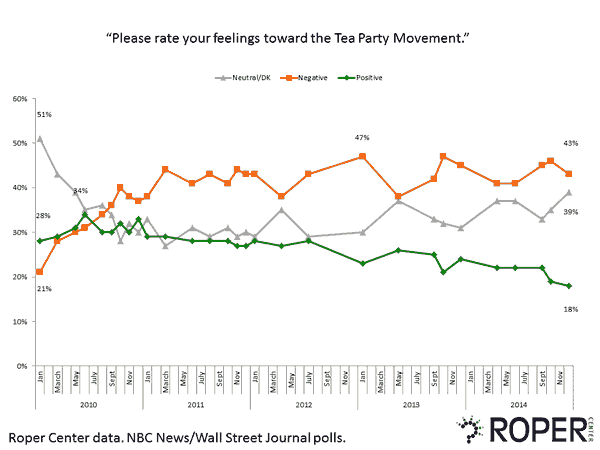
Like the mainstream news media, pollsters have been very interested in the Tea Party. Public opinion polls have included questions about support for the TPM multiple times per year since 2010. Support for the Tea Party peaked in May of 2012 at 30%, and has steadily declined to levels in the low 20s since then, and dropped to 17% at the end of 2014. 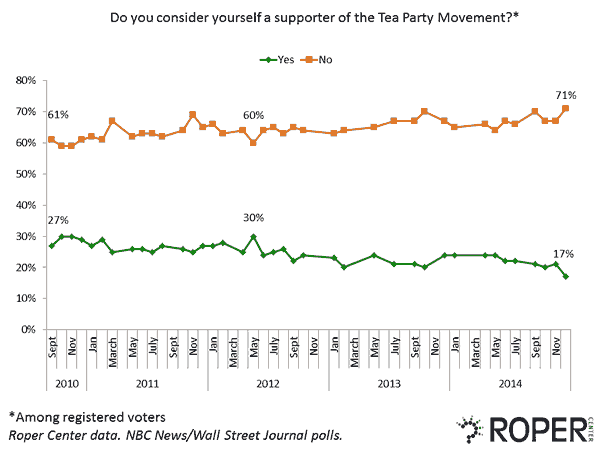
Opinions on Occupy
Pollsters didn't ask nearly as many questions about the OWS movement, and stopped asking questions in the summer of 2012. The highest percentage of people who claimed to support OWS was 28% in November 2011, when media coverage of the movement was also at its highest point. As police in various cities across the country began arresting greater numbers of OWS activists in late November and December of that year, support began to fall. 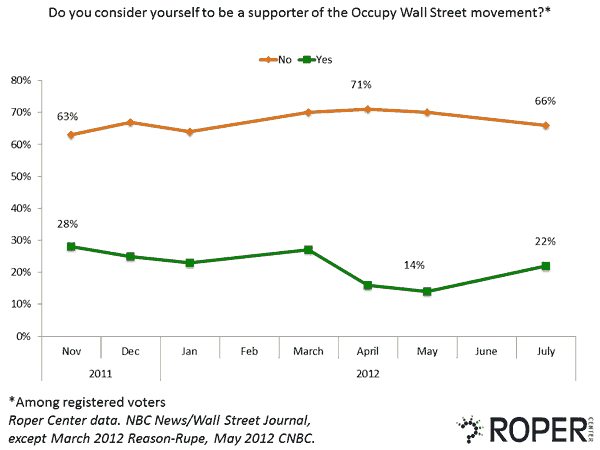
Similarities and Differences
Supporters of both movements express dissatisfaction with the current system of taxation, but prefer opposite solutions. According to a NBC News/Wall Street Journal poll from November 2011, 66% of TPM supporters would like a flat tax system, and 76% of OWS supporters would like a graduated income tax. A December 2011 NBC News/Wall Street Journal poll found OWS supporters to be more optimistic than TPM supporters. When asked whether they think the economy will improve or get worse, 45% of OWS supporters believed the economy would improve over the next year, compared to 19% of TPM supporters. The majority of supporters from both movements thought the economy would stay about the same. 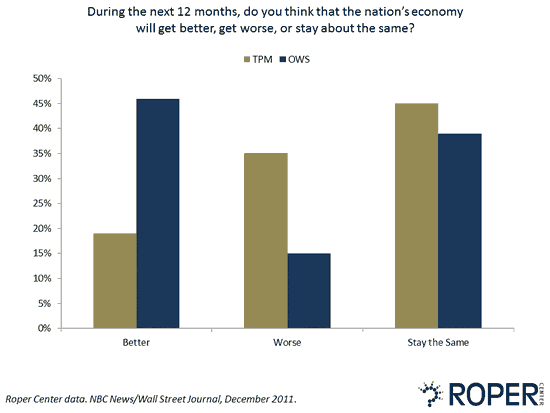
A February 2012 Gallup poll asked the public whether their vote for president that year would be influenced by some specific views held by the presidential candidates. TPM and OWS supporters agreed on the importance of two issues: 95% of TPM supporters and 87% of OWS supporters said that views on the economy were extremely or very important; and 81% of TPM supporters and 62% of OWS supporters said that views on taxes were extremely or very important. A key difference appears when people are asked whether a presidential candidate's views on the gap between rich and poor are important. About a third of TPM supporters said it is extremely or very important, while 83% of OWS said the same.
The Partisan Divide
A closer look at opinions on these issues reveal that, while TPM and OWS supporters may more or less agree on the level of importance of some issues, they are divided on which of the two main political parties is better suited to address those issues.
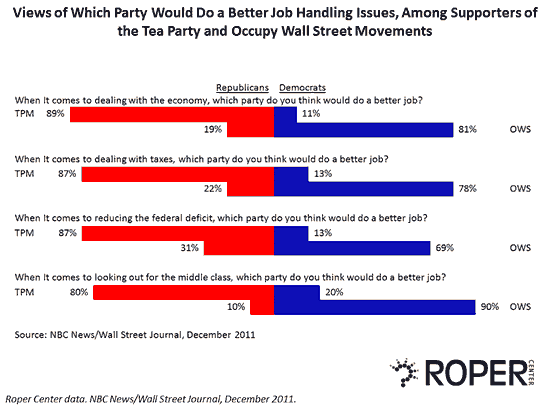
Although activists from both movements claim to act independently of political parties, each movement's supporters are clearly divided by party lines. This is further illuminated when examining where supporters of each movement place the blame for the economic problems of 2011. 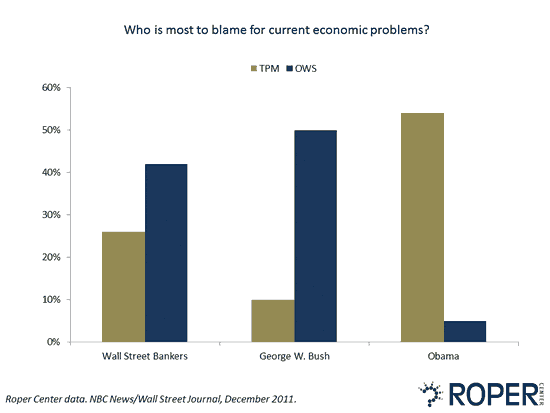
Some of these differences between TPM and OWS supporters may be partly explained by their regional differences. While OWS supporters are fairly evenly spread throughout the country, most live in the West; most TPM supporters are concentrated in the South.
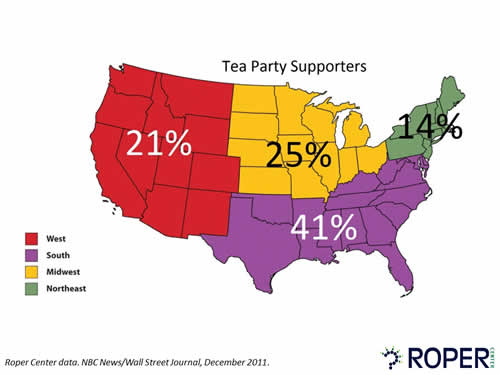
Although the TPM and OWS movements may have been initially motivated by some similar issues, the underlying concerns and overall goals of each movement couldn't be more different. While OWS has all but vanished from public discourse, the TPM has been a mainstay. This is mostly due to the success the TPM achieved in electing some of its own activists to political office, and to the GOP's embrace of some of the TPM's overarching issues of concern, especially among Republican members of the House of Representatives. Despite having support from only a minority of Americans, the TPM has accomplished what few movements before them have been able to do: remain relevant after 6 years. http://dailycaller.com/2010/02/24/tea-party-activists-circulate-declaration-of-independence-and-distance-selves-from-republicans/ retrieved October 14, 2014. http://www.sodahead.com/united-states/tea-party-groups-declare-independence/blog-267453/?link=ibaf&q=how+many+groups+support+declaration+of+tea+party+independence+2010%3F retrieved October 14, 2014. Malaena Taylor is a Ph.D. candidate from the Sociology Department at the University of Connecticut. Her dissertation focuses on mass media and public opinion as mediating factors in the complex relationship between the state and social movements."
